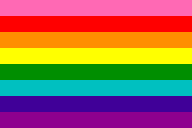Flag History
Serving from 1970 to 1972, Gilbert Baker was stationed as a medic in the San Francisco area. After he left the US Army, he found purpose in sewing protest banners for anti-war protests and creating his own clothes for drag. Until this point, the main symbol used by gay people was a pink triangle, the symbol used to separate gay men in Nazi concentration camps.
Many gay rights activists around 1978 saw the need for a new symbol to rally around; one not associated with such a dark period for the community. With an upcoming parade through San Francisco, a decoration committee was set up, which Gilbert Baker co-chaired.
Accounts vary between where the idea for the rainbow came from. Some sources say the idea came to Gilbert Baker while watching a friend dance and seeing the colors of other dancers spin. Others say that Lynn Segerblom, also known as Faerie Argyle Rainbow, would bring the idea to the decorations committee. No matter where the idea came from, the committee was in agreement that two rainbow flags should be made.
The decorations committee petitioned Harvey Milk, a gay city supervisor, for funds to be able to create the flags. He managed to find $1000 (approximately $4500 in 2022) from the previous year's hotel taxes. 2 large flags would be made, with 18 more smaller ones being put into a reflection pool along the parade route. They would need someone to lead the effort in sewing this new symbol, and with his knowledge of working with fabric, this task fell to Gilbert Baker.
The production of the flag involved 100 volunteers across the United States, with sometimes 30 people working on it at once. Dying the fabric was led by Lynn Segerblom, and involved people carrying hot water onto the roof where they had the space and drainage to do the dyeing. Feeding the fabric through the sewing machine took an extra pair of hands, provided by James McNamara.
The first one had stripes in the order pink, red, orange, yellow, green, blue, indigo, and violet. The second flag had that order reversed, and added stars on a blue field in the top left to call back to the American flag. Gilbert Baker is attributed with sewing the flags and popularising it across the globe.
Gilbert Baker assigned meanings to each of the stripes, a tradition continued in most pride flags since. Accounts from other members of the flag creation team say this was Baker's idea, saying that the rainbow represents everyone by default. Baker's associations were:
- Hot pink: Sex.
- Red: Life.
- Orange: Healing.
- Yellow: Sun.
- Green: Nature.
- Turquoise: Art.
- Indigo: Harmony.
- Violet: Spirit.
On June 25th 1978, the new rainbow flags flew in the San Francisco Gay Freedom Day Parade. Later that year, Harvey Milk (the city supervisor who found the funds), was assassinated in a politically motivated attack by a previous city supervisor in the San Francisco town hall.
Variants
Another large flag was created for the parade, featuring stars on a blue field, reminiscent of the flag of the United States.
After the assassination of Harvey Milk, demand for the flag grew. This led the local Paramount Flag Company to produce the flag using regular 7-stripe rainbow fabric. Due to this, and a lack of readily available pink fabric, Gilbert Baker stopped adding the pink stripe to the flags he was producing. Baker would later work at the Paramount Flag Company producing flags.
The design would again change in 1979, where the street lamps along the parade route would be adorned with the flag. The decision was made to split the design into two banners of three stripes, so that one side of the street would be red, orange, and yellow, while the other would be green, blue, and purple. This led to the familiar 6-stripe flag.

